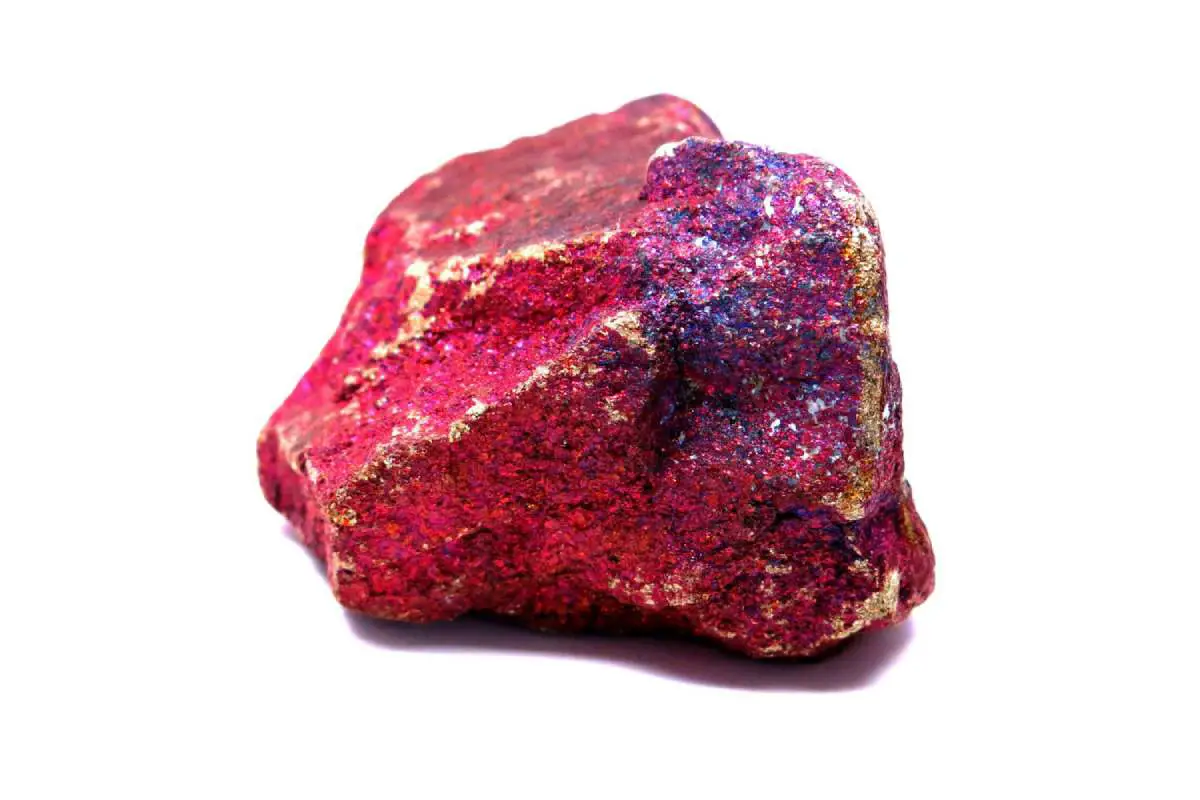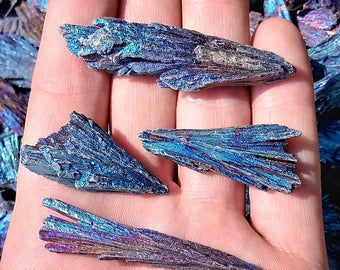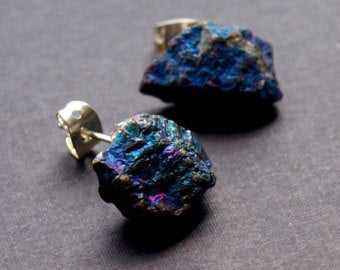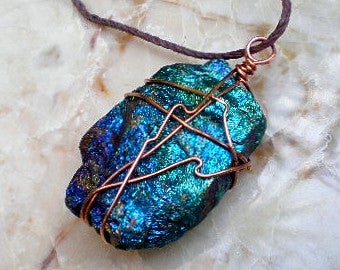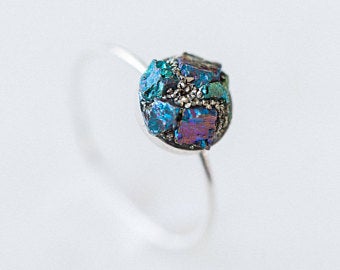Nicknamed peacock ore, bornite is a visually appealing gemstone due to its spectrum of rainbow colors coming from copper-rich minerals. The stone is also known for its captivating iridescent colors and sparkling appearance in the sunlight.
Obviously, this makes it a tempting option for use in jewelry. So, is it that widely used in jewelry? How powerful are its metaphysical properties? Let’s find answers to these questions and explore more about this stone in this post.
Meaning
Peacock ore or bornite was first spotted in the early 18th century in the Czech Republic’s Krušné Horny Mountains. However, it got its name in the mid-19th century after Ignaz von Born, a European mineralogist.
Peacock ore is a trading name for gleaming bornite and chalcopyrite minerals. As the old Mexican miners used the name for the first time to refer to tarnished bornite, a few people think that real peacock ore is bornite and that chalcopyrite peacock ore is forged. However, in reality, both can naturally tarnish in a bright display of metallic colors.
For the metaphysical community, peacock ore is a new gemstone. Thus, it was not included in any old text pieces or lapidaries describing the powers of different gemstones.
The rainbow colors of this stone are known to trigger joy upon a glance, due to which it is the stone of happiness. It has highly robust energies to remove negative feelings and trigger a profusion of happiness and joy.
The stone is also known to help in recognizing and experiencing joy via a smoother transition through life. It gives a feeling of lavishness and richness, which it can make its holder happy.
Properties
Physical Properties
Peacock ore or bornite refers to a crystalline form of chalcopyrite in the orthorhombic structure, both having similar physical but different metaphysical or healing properties. Bornite usually exists together with the more predominant chalcopyrite mineral in copper deposits.
It is copper iron sulfide present in sulfide copper deposits, contact metamorphic rocks, igneous and sedimentary rocks, and hydrothermal veins. While bornite refers to a natural, untreated stone, peacock ore is its heat-enhanced state.
Although rare, bornite can have naturally occurring rainbow colors. Thus, peacock ore is a form of bornite although it also contains chalcopyrite. Chalcopyrite typically has brass-yellow to gold-yellow shades but bornite does not display them until tarnished.
Bornite is spotted copper-red in its fresh state, although it is usually mixed with chalcopyrite. However, when exposed to air, it easily tarnishes and results in yellow, purple, blue, and green iridescence in some areas.
This gives us peacock ore whose wonderful colors are related to the bornite’s physical and chemical traits. When the ore gets tarnished or becomes dark, it means it loses its color and gains a metallic finish.
This finish reflects beautiful shades of red, blue, yellow, brown, and purple. The mix of different tones gives it a peacock-like look. Thus, the gemstone has a wavelength of amazing colors ranging from greenish-yellow to bluish-purple or a combination of all four.
Peacock ore is found in mass accumulations and rarely as tiny crystals. When fresh, it features a metallic sheen. On the Moh’s scale, its hardness is between 3 and 3.25. Its symmetry is orthorhombic and its tenacity is brittle.
Metaphysical Properties
Peacock ore is believed to have optimistic energy through which its holder or user can feel more joyful while performing spiritual practices. It makes us recall that we should not take life or spirituality too seriously and seems to murmur that we should laugh as much as possible.
This stone of joy is also likely to help in giving happiness to others and is known to show positive directions. It triggers in you the ability to recognize and value the joy present in every moment. It also brings in the feeling of acceptance; meaning you accept things, people, and circumstances exactly as they are.
It is believed to foster an understanding that nothing is wrong in any domain of life; everything exists for a purpose and that it is your perception that gives rise to different opinions. The stone can trigger a fresh, new feeling and kindle your inner spirit to take you to high levels.
Peacock ore also boosts prosperity and abundance inside and outside. While it pulls comfort towards you outside, it triggers a feeling of gaining everything that is needed or wanted.
This gemstone encourages keeping an awareness of internal abundance and the wisdom that the source of abundance is always within. The stone is known to support fiscal and material security, inner peace, and gratitude for what all is there with you.
It helps in remaining in the present moment and being in peace, no matter what the circumstances are! Peacock ore is helpful when it is a matter of facing negative energy and aids in finding circumstances that will assist in self-evolving and self-awakening.
It has the power to make you recognize any negative energy and defend you from it anytime. It is not essential to wear this stone for getting this protection; just keeping it in your pocket will also help.
The stone, interestingly, provides other types of protection, including from sickness. It is known to keep the baby in the womb and the would-be mother safe and healthy.
It is also believed that this stone defends from heart attacks and cerebral hemorrhage. The stone is admired for its energies affecting new beginnings and re-births positively.
Peacock Ore is considered one of the most robust stones when used for chakra healing. This is despite the fact that it is most commonly associated with the Solar Plexus chakra.
The reason is its all-embracing energy. In simple words, placing it on one chakra affects all the remaining ones. Still, at a time, it can kindle individual chakras.
If you use this stone during meditation, it can extend and reinforce your connection to the vast spiritual kingdom as well as with the earth below us. The stone is associated with the Fire and Earth elements.
It is associated with Kwan Yin, the deity of compassion, which means you can use it to ask for her help. The stone is also beneficial while performing Chi-moving practices such as acupuncture, acupressure, and Tai Chi. This is because it aids in shifting Chi and split energy jams.
Peacock Ore is considered highly useful when the mind and heart do not seem to be united, particularly on vital topics such as livelihood and relationships. It is known to impact the heart and mind such that the interaction with each other becomes clearer. As a result, it becomes easy to take the most favorable decisions.
The stone persuades its users to be courageous enough to accept real love and find practical ways to fulfill all fair dreams. Once in a happy relationship, the stone is likely to help in uplifting it to another level for gaining more happiness.
Where to buy Peacock Ore
Usually Etsy or Amazon is a good idea. Etsy is the leading online global marketplace of handmade, vintage, and creative goods. Amazon is one of the largest global online marketplaces. Both of them are reliable and easy to find your favorite items there.
Peacock Ore in jewelry uses
Bornite’s variant, peacock ore, is famous for its iridescent tarnish due to which it is available on sale to tourists and amateur mineral collectors. Although a form of bornite, in reality, peacock ore is mostly available as modified chalcopyrite. When treated with acid, chalcopyrite results in a strongly colored rainbow-like tarnish.
Apart from being used as a rock collector’s specimen, peacock ore is used in decorative and aesthetic items for offices and homes. However, it is not that widely used in jewelry due to its low hardness level.
Still, some specimens are used as cut-out cabochons for use in necklaces, pendants, bracelets, cufflinks, and earrings. Of all, you will commonly spot the stone in necklaces and bracelets.
Where does Peacock Ore come from
Peacock ore is commonly found in Connecticut, Arizona, Peru, Montana, and Morocco. The ore’s largest crystals are seen in Kazakhstan, while significant deposits are also spotted in Zimbabwe’s Congo and Shaba.
Large quantities come from Michigan, Wisconsin, Austria, New Jersey, Colorado, and Pennsylvania. Bornite also occurs in Quebec and British Columbia.
England’s Cornwall is where you can find specimens of Bornite along with a few crystallized specimens. Very stunning crystals come from San Martin in Mexico, while large Bornite crystals are found in Arizona.
How much is Peacock Ore worth
The worth of peacock ore is insignificant because it is available in abundance. However, there are some rarely found specimens, especially the naturally occurring ones, that are costly. The value of this crystal is determined by its size, uniqueness, and color hues.
While a normally-sized specimen is cheap, rock collectors looking for larger specimens usually end up paying much more than what is for the former. Similarly, the more attractive the color or more the shades, the higher the price will be.
Typically, some costlier bornite specimens will contain chalcopyrite. Peacock ore is available as raw or tumbled stones both of which are used in jewelry. The cost of both types varies as per the metal used to make the jewelry but is affordable overall.
How to identify Peacock Ore
The majority of artificial peacock ore is made using chalcopyrite. Although many people refer to it as bornite or chalcopyrite, most of its specimens at shows, museums, and shops are essentially chalcopyrite.
This chalcopyrite has been treated with an acid to result in a rainbow-colored appearance. This treatment is done to make the stone more appealing for selling it quickly. The resulting colors and look significantly surpass the expected appearance on the surface of bornite.
For accurately distinguishing between bornite and chalcopyrite, consider chipping the stone to remove its small section. If it is genuine bornite, the broken area will have a brown surface and will discolor quickly.
If it is chalcopyrite, the interior will be glimmering gold or silver with a metallic surface, which shall remain in this condition. In short, it will not tarnish. Genuine bornite will quickly tarnish black, while treated chalcopyrite will preserve its rainbow-colored look for a very long time.
Thus, a peacock ore specimen will not tarnish if it is treated with chalcopyrite, which is what buyers and collectors commonly get. Overall, it is easy to recognize bornite, a common ore of copper, due to its ability to tarnish swiftly to iridescent shades of green, blue, yellow, and purple.
Due to these iridescent colors, it is also called purple copper ore. The iridescent tarnish and low hardness set apart bornite from other minerals having a metallic to sub-metallic luster. Some of them feature a similar discoloration while most of them are harder.
How to use Peacock Ore
There are a couple of ways to use peacock ore. You can carry the stone with you by keeping it in a pouch or bag or simply put it in the area where you execute your creative work activities.
When you use the crystal in any of these ways, keep an intent that it works for you in whichever field you want its help. Another way to use peacock ore is to hold it in your palm once you cleanse and recharge it.
You may hold one or a couple of peacock ore crystals. You can even hold it in your hand in the meditation pose or put it near your bed. The raw peacock ore stones in their natural state can be put in any room or held in the hand while meditating.
Deemed to be one of the most powerful healing stones in the mineral realm, using this stone during meditation is considered highly beneficial. While holding in your hand, just affirm that no negative energy can enter my space and only light and peace surround me.
According to some experts, wearing or carrying peacock ore is likely to trigger a few healing effects. These proposed effects range from increased happiness and joy to detecting and removing negative energies from your body.
Peacock ore jewelry is worn to gain the benefit from its physical properties. Interestingly, if this stone is positioned over the waist, it is known to aid in controlling the adrenaline flow.
Wearing it here can also help in controlling the acid levels in the body. The stone is also known to boost the potassium level and reduce the surplus amount of calcium when worn above the waist.
If you wear it below the waist, the stone can help in boosting blood circulation as well as the acid level. It will also kindle adrenaline and stabilize sodium preservation when worn here.
How to cleanse Peacock Ore
The best way to clean this colorful stone is smudging. Although burning sage is common, it is also fine to burn cedar or sweetgrass. Once the smoke is seen, just hold the crystal over it for a couple of minutes. You can even clean this stone by keeping it under the moonlight. For charging it, consider keeping it under sunlight.
Is Peacock Ore the same as Chalcopyrite
Technically, the answer is No! Peacock ore is usually acid-treated chalcopyrite. Upon exposure to acid, chalcopyrite’s color palette amends to show different hues. This is what most shops and shows sell. Technically, peacock ore is tarnished bornite, a mineral that naturally dulls to show rainbow colors.
Thus, you need to be careful while purchasing. Tarnished bornite is quite rare, due to which it is essential to check the genuineness of what you are buying. Treated chalcopyrite is usually cheaper than tarnished bornite.
It is worth noticing that a fresh bornite specimen will have a reddish or bronze color with a streak of grey or black. A greenish tinge or dark bluish grey means it is fresh chalcopyrite. Moreover, a knife will more easily cut chalcopyrite than bornite.
The Best Combination to use with Peacock Ore
For better outcomes, you can use peacock ore with other gemstones or crystals. These stones are citrine, sunstone, red cinnabar, golden apatite, golden rutile in quartz, Libyan desert glass, and golden labradorite. Other stones with which you can use peacock ore are Libyan gold tektite and moldavite.
To demonstrate an effective mystic vibration, consider using it with crown chakra crystals. It is vital to know that peacock ore and iron pyrite are similar in many ways due to strong manifestation properties. For boosted mediation results, consider combining this ore with dendritic opal, labradorite, titanite, blue azurite, and clear quartz.
When it is a matter of pairings, it is essential to consider the uses of peacock ore. Just meticulously think about what you want to accomplish with the stone so that you can choose the right pair from so many options.
Final Words
Peacock ore, with its rainbow-colored surface, is one of the most stunning crystals. Although called bornite or chalcopyrite, peacock ore available for sale in the market is acid-treated chalcopyrite.
It is rare to come across a naturally occurring peacock ore due to tarnishing of bornite, as this process takes several centuries to occur. Bornite is also relatively sketchily colorful and finally turns black. However, chalcopyrite will never tarnish or turn black naturally.
Due to its low hardness rating, this stone is brittle and is less widely used in making jewelry. However, its pendants and necklaces are quite commonly spotted.

